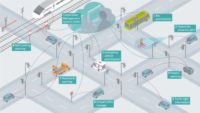DETROIT—Cavnue and the Michigan Department of Transportation have selected a 25-mile stretch of I-94 that will form the first connected and autonomous vehicle (CAV) corridor in the United States. The heavily travelled highway links Ann Arbor, MI, and Detroit.
The initiative calls for a special lane equipped with infrastructure that enables the deployment of fully automated driving systems for buses, cars and trucks. The long-term goal is to ensure safer roads, fewer casualties, reduced traffic congestion and increased traffic efficiency. Automakers such as Ford, General Motors, Honda, Hyundai, Stellantis and Toyota are involved in the project.
“With billions of dollars already invested in intelligent, connected and autonomous in-vehicle technology, [we] will take these technological advancements one step further by adding the roadway into the connected driving experience,” says Tyler Duvall, CEO of Cavnue. “By partnering with leading companies across the industry, [we are] working to build connected and autonomous vehicle corridors that [save lives by reducing crashes, boost productivity by cutting time wasted in traffic, and increase access to personal and shared mobility].”
According to Duvall, Cavnue’s smart road platform will enhance vehicle performance experiences through vehicle-to-infrastructure connectivity. By closely collaborating with automakers, the OEM-agnostic technology will help fully realize the benefits of ADAS features and AVs.
Duvall says the innovative project is designed to improve safety, as well as the overall driving experience; achieve technology neutrality among automakers through standards-based approaches; and enhance accessibility, affordability and equity for all roadway users and residents. He expects the I-94 corridor will eventually be expanded further in Michigan and across the rest of the country.
“There is no denying, the future of vehicles is connected and automated,” explains Duvall. “A network of CAV lanes powered by integrated hardware and software...can ensure that the future is safe and efficient.”



